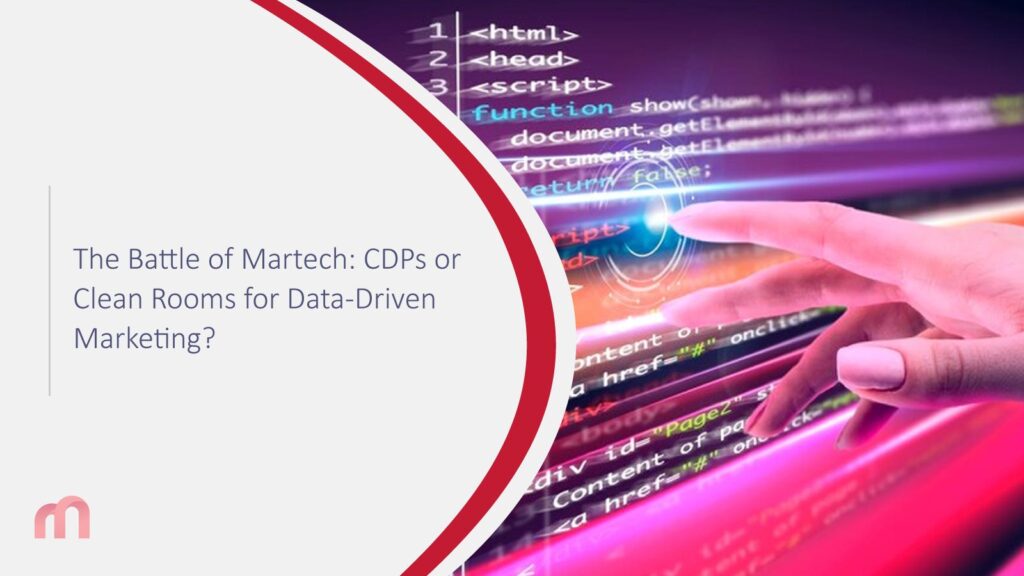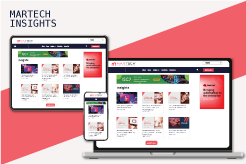Introduction: Who Reigns Supreme in the Data Duel?
Suppose your marketing team is sitting on a treasure trove—your customer data. But there’s a catch: the treasure is not the data itself, but the knowledge of what to do with it. Enter the two data-driven marketing heavyweights—Customer Data Platforms (CDP) and Data Clean Rooms.
In the privacy-first era of today, both Clean Rooms and CDPs are transforming the way marketers engage with their audience. But which one puts your brand in the driver’s seat? Whether you’re attempting to personalize experiences or remain compliant with regulations, read on to make a wise, data-driven choice.
Let’s get into this showdown of Martech giants, where data control, benefits, and features are the true differentiators.
What is a CDP?
Customer Data Platforms (CDPs) integrate customer data from disparate sources into a single, consistent, always-up-to-date, and centralized repository. They provide marketers with a 360-degree understanding of the customer journey. And yes, CDPs are not for IT alone but for marketing teams as well. Such platforms enable brands to harness data-driven insights for real-time decision-making and enhanced customer engagement across all digital channels.
CDPs also act as the single source of truth for your first-party data, ensuring that you meet privacy regulations but still have rich user experiences. Whether retail, finance, or media, a CDP enables you to convert insight into action quicker than you ever thought possible.
Key Features of CDP:
- Collecting data in real time from email, CRM, websites, and beyond.
- Identity resolution to reconcile customer profiles across channels.
- Segmentation and building of audiences for campaign targeting.
- Scale Personalization, fueled by harmonized data.
- Orchestration Omnichannel for delivering unified customer experiences.
According to the CDP Institute, 75% of all companies utilizing CDPs indicated improved customer engagement.
Use Case:
Suppose you operate a retail brand. Your CDP can gather a shopper’s online activity, cross-reference it with previous in-store purchases, and enable you to send a timely discount via SMS. Easy peasy, right? It’s how brands provide frictionless experiences and consistent messaging to customers at every touchpoint along their journey.
What is a Data Clean Room?
Data Clean Rooms are private rooms where brands are able to reconcile their first-party data with the data of another party—such as a publisher or platform—without exposing raw personally identifiable information (PII). These privacy-first solutions are transforming the way advertisers work together securely without breaching sensitive information.
These rooms are virtual conference tables where brands and partners silently and compliantly analyze overlapping customer data in private. They protect data integrity while allowing for wiser marketing choices.
Clean Rooms are commonly employed in media, retail, and healthcare industries, where data is highly sensitive. They are made for sophisticated analytics, attribution modeling, and safe audience insights that safeguard all stakeholders.
Main Characteristics of Data Clean Rooms:
- Data collaboration with advanced encryption that’s privacy-preserving.
- No sharing of raw data between parties.
- Fine-grained access and usage control.
- They integrate well with walled gardens such as Google, Amazon, and Meta.
- Support for high-join data without compromising rule compliance.
Why It Matters:
Gartner survey: 80% of marketers intend to invest more in privacy-protecting technology by 2026—and clean rooms lead the way.
Use Case:
A streaming service can collaborate with an ad agency to find common audiences for a campaign, without either party seeing full customer data. These partnerships are transparent, yet powerful cross-platform insights drive impactful results.
CDP vs Clean Rooms: A Feature-by-Feature Comparison
| Feature | CDPs | Clean Rooms |
| Data Ownership | Full internal control | Shared control (with restrictions) |
| Real-time Personalization | Yes | No (used more for insights and planning) |
| Privacy Compliance | Moderate | High (especially for sensitive data) |
| Integration Complexity | Low to Moderate | High (often requires technical expertise) |
| Use Cases | Email, SMS, personalization, retargeting | Cross-brand collaboration, analytics |
| Best For | Marketers focused on activation | Data teams focused on measurement |
The above feature comparison shows how CDPs and Clean Rooms serve different points along the data lifecycle, from data collection to collaboration. They play complementary roles and provide distinct value that enables brands to make wiser marketing choices.
When to Use CDP
Go with a CDP if:
- You desire real-time, tailored marketing.
- You require a singular view of the customer interactions.
- Your marketing organizations desire control with minimal technical support.
- You intend to use behavior-based customer journey automation.
- You want to build durable customer relationships through data.
Select CDPs when your focus is on activating insights in a hurry, personalizing experience in real-time, and improving direct marketing efforts effectively.
Best CDP Tools:
- Segment – Popular with flexibility and developer-centric tools.
- Treasure Data – Enterprise-level capabilities.
- BlueConic – Best suited for marketer-driven workflows.
- mParticle – Works well with mobile and app ecosystems.
- Tealium – Has robust data governance features.
Case Study:
According to Segment Customer Stories, The North Face utilized a CDP to boost email open rates by 35% via more intelligent segmentation. Their digital experience was made more intuitive and relevant, which resulted in improved conversion rates. They were also able to deliver contextual content on web and mobile apps with greater precision.
When to Use Data Clean Rooms
Clean Rooms are the ideal solution when:
- You must work on data together with companies or platforms.
- Data privacy is a top concern.
- You deal extensively with big tech “walled gardens.”
- Your analytics team requires safe, shared audience analysis.
- You operate in a regulated industry with strict data treatment.
- Clean Rooms enable marketers to find insights in shared data sets without sacrificing privacy. Apply them for attribution, campaign measurement, or audience overlap studies.
Best Clean Room Providers
For brands aligned closely with Google platforms, Ads Data Hub offers a data-centric advantage for campaign insights.
Amazon Marketing Cloud – Ideal for e-commerce and CPG brands.
Infosum – Enables decentralized data collaboration.
Snowflake Clean Room – Offers SQL-based secure analysis at scale.
Habu – Easy-to-use interface for marketers.
Case Study: Amazon Advertising Case Study
PepsiCo utilized a clean room to work with retailers without sharing customer-level data. This optimized ad placements and generated 30% more ROAS. The partnership led to improved campaign performance and greater insight into path-to-purchase behaviors.
The Synergy: Why Not Both?
Here’s a little-known secret that many successful marketers are adopting—you don’t have to pick one. Merging a CDP with a Data Clean Room gives you the best of both worlds.
How They Work Together:
- CDPs gather and consolidate your first-party data.
- Clean Rooms allow you to safely match that data with external platforms.
- It uncovers useful patterns while keeping individual data more secure.
- Your team has more visibility across internal and external data sets.
- Campaigns are more relevant, measurable, and forward-looking.
This integrated strategy makes personalization more effective, ensures regulation, and enables brands to scale their marketing programs with confidence and precision.
Example Workflow:
- Gather user data through your CDP.
- Push anonymous segments into a Clean Room.
- Work with publishers or ad platforms.
- Measure overlap and optimize campaigns—without sacrificing data.
FAQs
Q1: Are Data Clean Rooms and CDPs interchangeable?
No, they are used for distinct purposes. CDPs organize and activate your data. Clean Rooms enable safe data sharing with partners while maintaining privacy.
Q2: Can one company use both of them?
Definitely! Several businesses utilize CDPs for in-house data and clean rooms for outside collaboration. This dual utilization tends to result in improved marketing results.
Q3: Is a CDP sufficient to achieve privacy compliance?
CDPs are a good help, but not invincible. Clean Rooms provide more levels of protection for the data, particularly in the sharing with third parties.
Q4: Do small companies require these resources?
Startups might not necessarily require a Clean Room immediately. But CDPs bring tangible value as soon as they help them know and connect with their customers better.
Q5: What’s the learning curve?
CDPs are marketer-friendly. While Clean Rooms offer powerful capabilities, the expertise of data engineers can further amplify their effectiveness. However, with the right configuration, they’re a breeze to work with.
Conclusion: Power Up Your Data Strategy
In the rapidly changing Martech environment, knowing your data is the key to gaining customer loyalty. CDPs provide personalized experiences, whereas Clean Rooms provide privacy and secure collaboration.
Both share the best of each, and together they yield a full-spectrum data strategy that’s future-ready. Whether you’re a marketing executive or a data scientist, these tools are building the next era of digital engagement.
So, why settle for one when you can use both? Tomorrow’s marketing landscape thrives on teamwork, intelligent strategies, and deep data insights.
Ready to elevate your data-driven marketing?
Stay subscribed to our weekly Martech insights newsletter. Check out top Martech integrations to maximize your ROI.
For media inquiries, you can write to our MarTech Newsroom at sudipto@intentamplify.com



